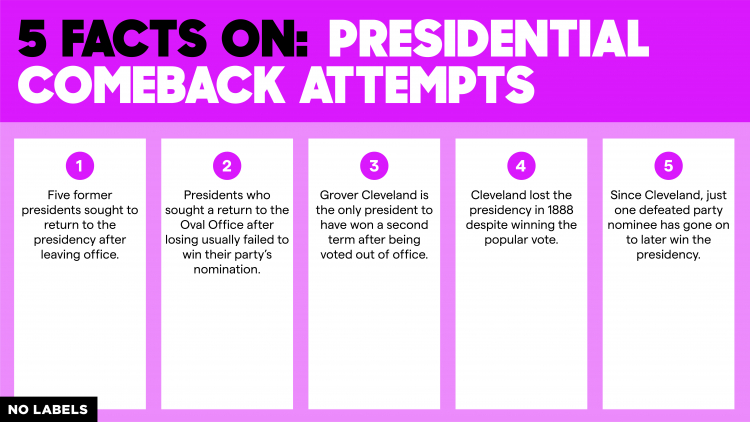Five Facts on Presidential Comeback Attempts

The Big Insight: A Donald Trump return to the White House would not be unprecedented — though most former presidents who have made comeback attempts have failed.
Donald Trump is hinting at a potential 2024 presidential run, and there is historical precedent for a defeated former president to later win back the office. But more often, former presidents — either defeated or retired — who sought a comeback failed to win their party’s nomination, let alone the election.
Here are five facts on presidential comeback attempts.

1. Five former presidents sought to return to the presidency after leaving office.
Trump would join several of his predecessors in seeking to return to the White House after leaving. Martin Van Buren, defeated for reelection in 1840, was the first former president to later try to regain the presidency. Millard Fillmore, Ulysses S. Grant, Grover Cleveland, and Theodore Roosevelt would later attempt the same thing.
2. Presidents who sought a return to the Oval Office after losing usually failed to win their party’s nomination.
Van Buren was the early frontrunner for the Democratic nomination in 1844, but lost the nomination to James K. Polk. Four years later, Van Buren accepted the nomination of the anti-slavery Free Soil Party, winning 10% of the popular vote but carrying no states. In that same election, Millard Fillmore was elected vice president. He became president in 1850 when Zachary Taylor died, but lost the Democratic nomination in 1852. Like Van Buren, he later ran as a third-party candidate, taking 22% of the vote in 1856.
Grant easily won both the 1868 and 1872 elections and chose to retire at the end of his second term. But four years later, he again sought the Republican nomination but lost at the party convention in the midst of a faction fight within the GOP.
Theodore Roosevelt was elected vice president in 1900, and became president when William McKinley was assassinated in 1901. Roosevelt won the 1904 election in a landslide, and retired in 1908. In 1912, he challenged William Howard Taft for the GOP nomination, and after losing at the convention, sought the presidency as a third-party candidate. He came in second, ahead of Taft, but lost to Woodrow Wilson.
Since that time, no former president has run for the job again, though Herbert Hoover and Gerald Ford each considered it.
3. Grover Cleveland is the only president to have won a second term after being voted out of office.
The only defeated president to later win his party’s nomination became the only former president to win back the White House. Grover Cleveland won a very tight race for the presidency in 1884 — with a popular vote plurality of fewer than 58,000 — but was defeated in 1888. In 1892, he returned to the White House, defeating the man who beat him in 1888, Benjamin Harrison, by three percentage points.
4. Cleveland lost the presidency in 1888 despite winning the popular vote.
Cleveland actually won the popular vote in his 1888 reelection bid by a wider margin than in 1884, leading Harrison by more than 90,000 votes, but lost the electoral vote 233-168. He was the last popular vote winner to lose in the Electoral College until Al Gore more than a century later. Trump also won the presidency in 2016 despite a popular vote defeat.
5. Since Cleveland, just one defeated party nominee has gone on to later win the presidency.
While former presidents often failed to win their party’s nominations in comeback attempts, former nominees occasionally won renomination. William Jennings Bryan was the Democratic nominee three times, Thomas Dewey was the GOP nominee twice, and Adlai Stevenson was twice the Democratic nominee. But only one defeated nominee, Richard Nixon, later won the presidency, coming back from his 1960 defeat to win in 1968.





